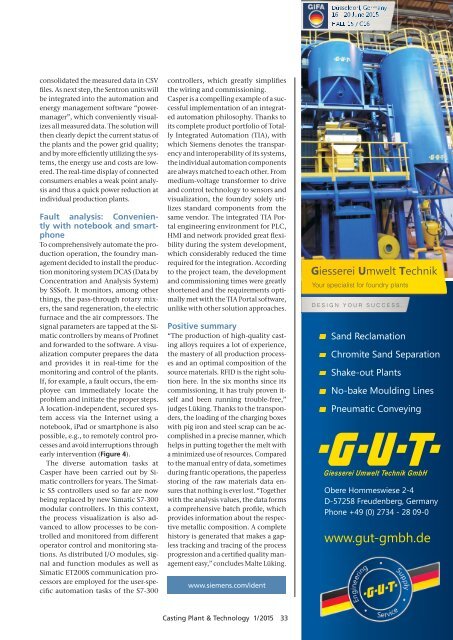CPT International 01/2015
The leading technical journal for the global foundry industry – Das führende Fachmagazin für die weltweite Gießerei-Industrie
The leading technical journal for the
global foundry industry – Das führende Fachmagazin für die
weltweite Gießerei-Industrie
Create successful ePaper yourself
Turn your PDF publications into a flip-book with our unique Google optimized e-Paper software.
consolidated the measured data in CSV<br />
files. As next step, the Sentron units will<br />
be integrated into the automation and<br />
energy management software “powermanager”,<br />
which conveniently visualizes<br />
all measured data. The solution will<br />
then clearly depict the current status of<br />
the plants and the power grid quality;<br />
and by more efficiently utilizing the systems,<br />
the energy use and costs are lowered.<br />
The real-time display of connected<br />
consumers enables a weak point analysis<br />
and thus a quick power reduction at<br />
individual production plants.<br />
tly<br />
with notebook and smartphone<br />
To comprehensively automate the production<br />
operation, the foundry management<br />
decided to install the production<br />
monitoring system DCAS (Data by<br />
Concentration and Analysis System)<br />
by SSSoft. It monitors, among other<br />
things, the pass-through rotary mixers,<br />
the sand regeneration, the electric<br />
furnace and the air compressors. The<br />
signal parameters are tapped at the Simatic<br />
controllers by means of Profinet<br />
and forwarded to the software. A visualization<br />
computer prepares the data<br />
and provides it in real-time for the<br />
monitoring and control of the plants.<br />
If, for example, a fault occurs, the employee<br />
can immediately locate the<br />
problem and initiate the proper steps.<br />
A location-independent, secured system<br />
access via the Internet using a<br />
notebook, iPad or smartphone is also<br />
possible, e.g., to remotely control processes<br />
and avoid interruptions through<br />
early intervention (Figure 4).<br />
The diverse automation tasks at<br />
Casper have been carried out by Simatic<br />
controllers for years. The Simatic<br />
S5 controllers used so far are now<br />
being replaced by new Simatic S7-300<br />
modular controllers. In this context,<br />
the process visualization is also advanced<br />
to allow processes to be controlled<br />
and monitored from different<br />
operator control and monitoring stations.<br />
As distributed I/O modules, signal<br />
and function modules as well as<br />
Simatic ET200S communication processors<br />
are employed for the user-specific<br />
automation tasks of the S7-300<br />
controllers, which greatly simplifies<br />
the wiring and commissioning.<br />
Casper is a compelling example of a successful<br />
implementation of an integrated<br />
automation philosophy. Thanks to<br />
its complete product portfolio of Totally<br />
Integrated Automation (TIA), with<br />
which Siemens denotes the transparency<br />
and interoperability of its systems,<br />
the individual automation components<br />
are always matched to each other. From<br />
medium-voltage transformer to drive<br />
and control technology to sensors and<br />
visualization, the foundry solely utilizes<br />
standard components from the<br />
same vendor. The integrated TIA Portal<br />
engineering environment for PLC,<br />
HMI and network provided great flexibility<br />
during the system development,<br />
which considerably reduced the time<br />
required for the integration. According<br />
to the pro ject team, the development<br />
and commissioning times were greatly<br />
shortened and the requirements optimally<br />
met with the TIA Portal software,<br />
unlike with other solution approaches.<br />
Positive summary<br />
“The production of high-quality casting<br />
alloys requires a lot of experience,<br />
the mastery of all production processes<br />
and an optimal composition of the<br />
source materials. RFID is the right solution<br />
here. In the six months since its<br />
commissioning, it has truly proven itself<br />
and been running trouble-free,”<br />
judges Lüking. Thanks to the transponders,<br />
the loading of the charging boxes<br />
with pig iron and steel scrap can be accomplished<br />
in a precise manner, which<br />
helps in putting together the melt with<br />
a minimized use of resources. Compared<br />
to the manual entry of data, sometimes<br />
during frantic operations, the paperless<br />
storing of the raw materials data ensures<br />
that nothing is ever lost. “Together<br />
with the analysis values, the data forms<br />
a comprehensive batch profile, which<br />
provides information about the respective<br />
metallic composition. A complete<br />
history is generated that makes a gapless<br />
tracking and tracing of the process<br />
progression and a certified quality management<br />
easy,” concludes Malte Lüking.<br />
www.siemens.com/ident<br />
Casting Plant & Technology 1/2<strong>01</strong>5 33


















